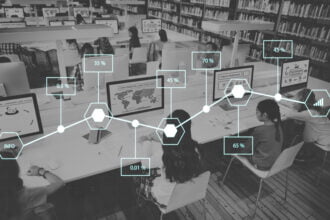Businesses have been using big data for years. Analyzing large data sets, they get invaluable insights and uncover patterns and trends in their area of interest. Yet, the concept of big data has evolved. Today, it goes beyond marketing purposes and thus can be helpful in many other industries, in particular in education.
Schools, colleges, and universities get benefits from the use of big data algorithms to process huge amounts of data, including information on students’ grades, attendance, and other records. Big data systems can help educational entities to interpret this information and enable informed decision making. They can also be used to improve teaching practices and students’ learning outcomes.
5 Ways to Use Big Data in Education
Educational requirements are continuously changing. As a result, there is always a need to update the existing practices and provide additional resources. There is no question that big data is shaping the education sector in novel ways. Big data is the key to make faster and better decisions. By collecting and analyzing data from different channels, educational institutions can get more tangible results. This process automatically provides more productive and efficient operations.
Big data technology in education primarily concerns data mining, analytics, and web dashboards. These processes provide information on students’ behavior patterns, needs, and results. The use of big data improves teaching and helps to identify opportunities. Besides, it also has the potential to enhance learning practices as well as develop customized courses for groups of learners with similar educational needs and requirements. Therefore, insights provided by big data analytics improve the overall operation of institutions, ensuring students’ success.
EdWeek has talked about some of the major changes that big data has brought to the industry. Have a look at the areas of the education sector that benefit most from the use of big data.
Better Learning Environment for Students
Each student leaves an original trail of data from the first day at school. When big data systems analyze this information, educators get the full picture of a student’s performance. Such results are more indicative than standardized tests as they consider a variety of different factors. Big data technology analyzes students’ preferences, favorite subjects, classroom activity, extracurriculars, in addition to grades and scores. It is useful if educators need to predict a student’s success and help him or her reach it. The results acquired from big data analytics provide the foundation for creating the best possible environment that will meet the needs of each student.
Easier Assessment
With the advantages that big data can provide, the process of assessing students’ progress becomes more straightforward. It enables teachers to develop better learning plans as they observe the correlation between the content of their lessons and students’ strength and problem areas. They see which students require more attention and some extra time to cope with the tasks.
If you are a student and you struggle with a certain subject, your teacher will suggest adaptive learning technologies. Yet, you can also improve your academic performance and impress your teacher with a well-written paper, asking EssayService for help. It is an easy way to cope with challenging subjects and keep pace with your peers.
Informed Career Choice
Another advantage of using big data in education is to help learners choose a future career. A performance report combined with students’ progress data across different courses is a solid foundation to predict their occupation. The technology can suggest the fields in which a learner is interested based on the strengths and weaknesses that he or she demonstrated during studies. Accurate career counseling helps students to perform well in school as they can focus on a specific industry.
Customized Courses
Big data in education can support the development of new pedagogical models within customized curricula. Static learning plans do not respond to the requirements of the modern world. Today we need an individualized and targeted approach supported by data-driven systems. The analysis and interpretation of students’ performance help educators to develop individualized plans and goals. As a result, students enjoy personalized learning experiences based on their preferences and capabilities. Besides, big data technology can provide certain feedback for teachers, helping them to improve their course materials and showing specific issues that require change.
Enhanced Decision Making
Big data systems can be applied to promote change and innovation in educational institutions. Processing students’ records, they provide access to conveniently organized and analyzed information. It enables the school administration to make decisions based on concrete indicators. These are engagement, grades, feedback from students, their activity, etc. For example, if a school needs to test a certain teaching method, educators can compare the results of the course where it has been implemented with any course where traditional approaches have been used. Therefore, big data technology empowers leaders to make informed decisions when choosing new development directions or implementing change.
To Sum Up
Big data can influence the whole educational continuum with better decision making, assessment, and enhanced learning outcomes. It helps educators to keep track of students’ performance and needs to offer them an advanced learning environment. Students will no longer be limited by static learning plans. Instead, if educators embrace the use of big data systems, they will be able to take the learning process to the next level, revolutionizing the whole sector.











